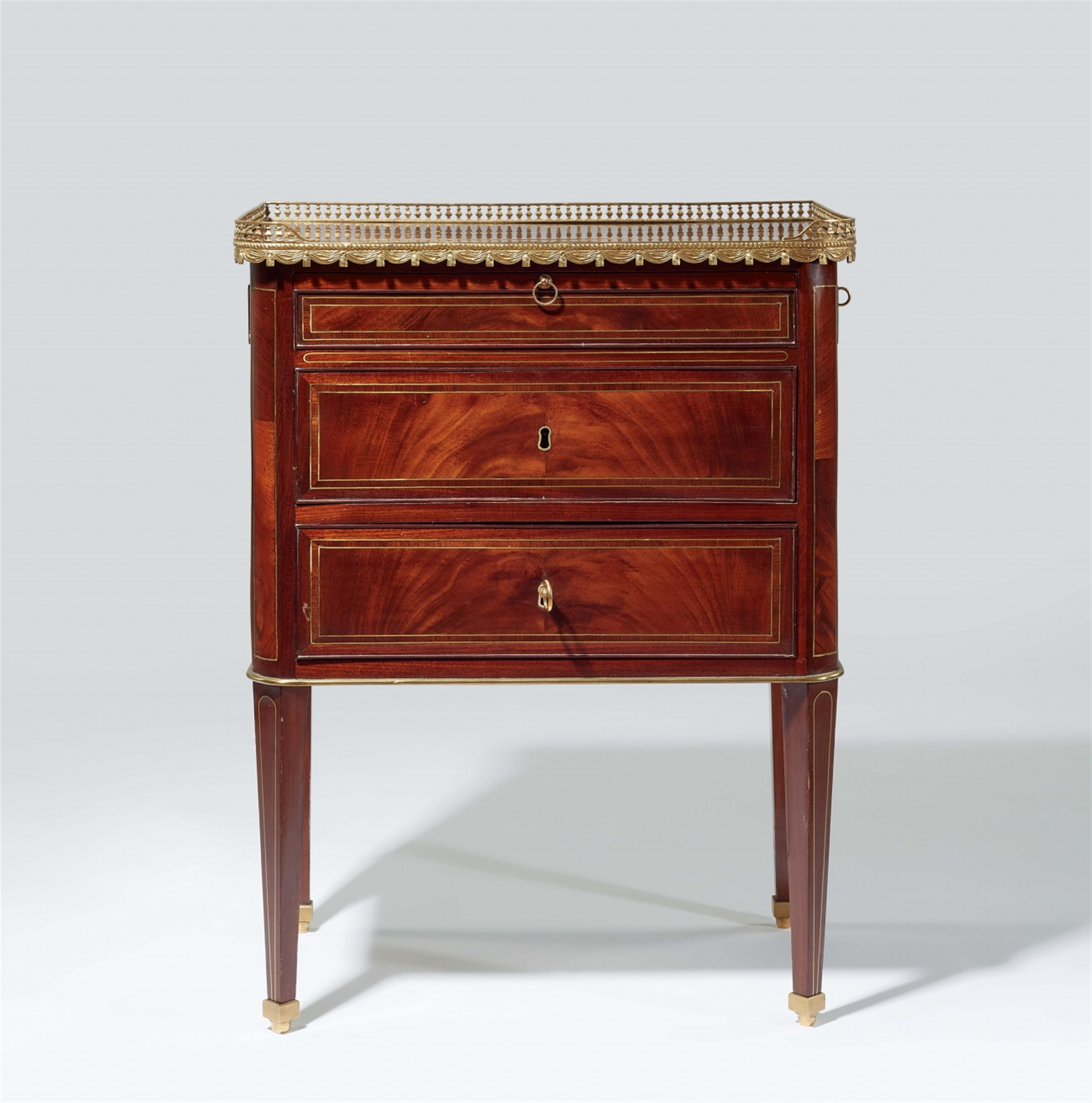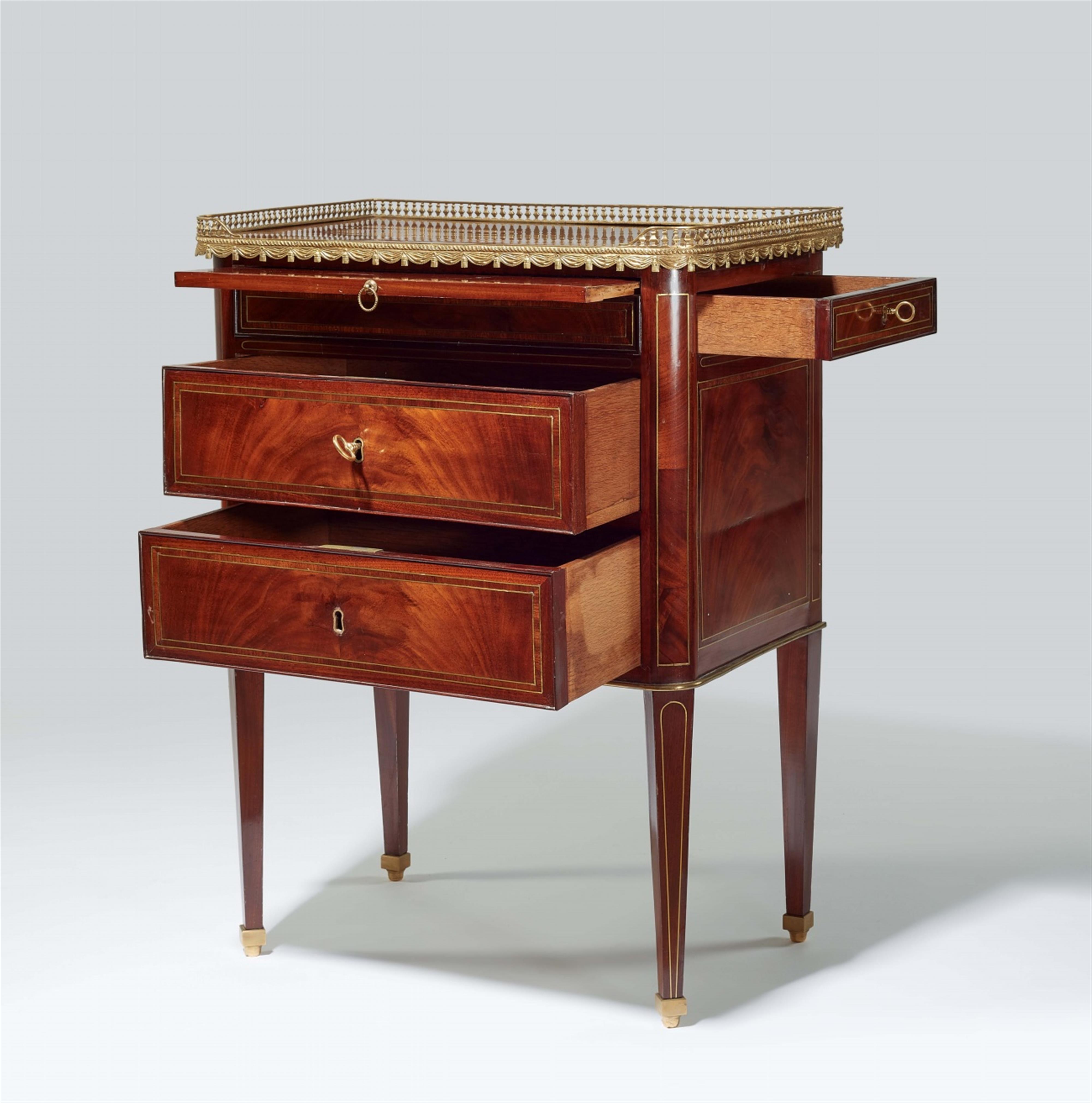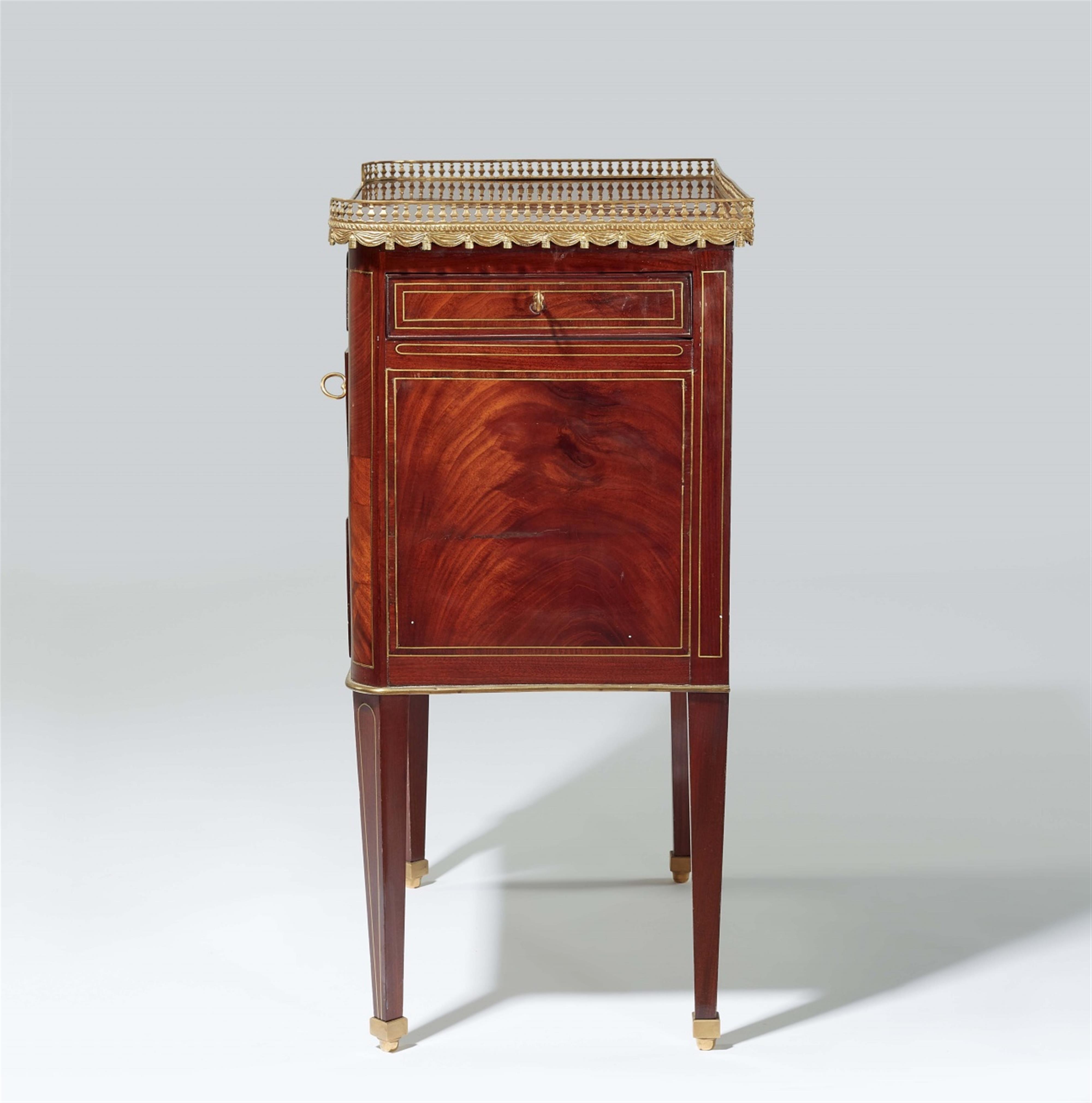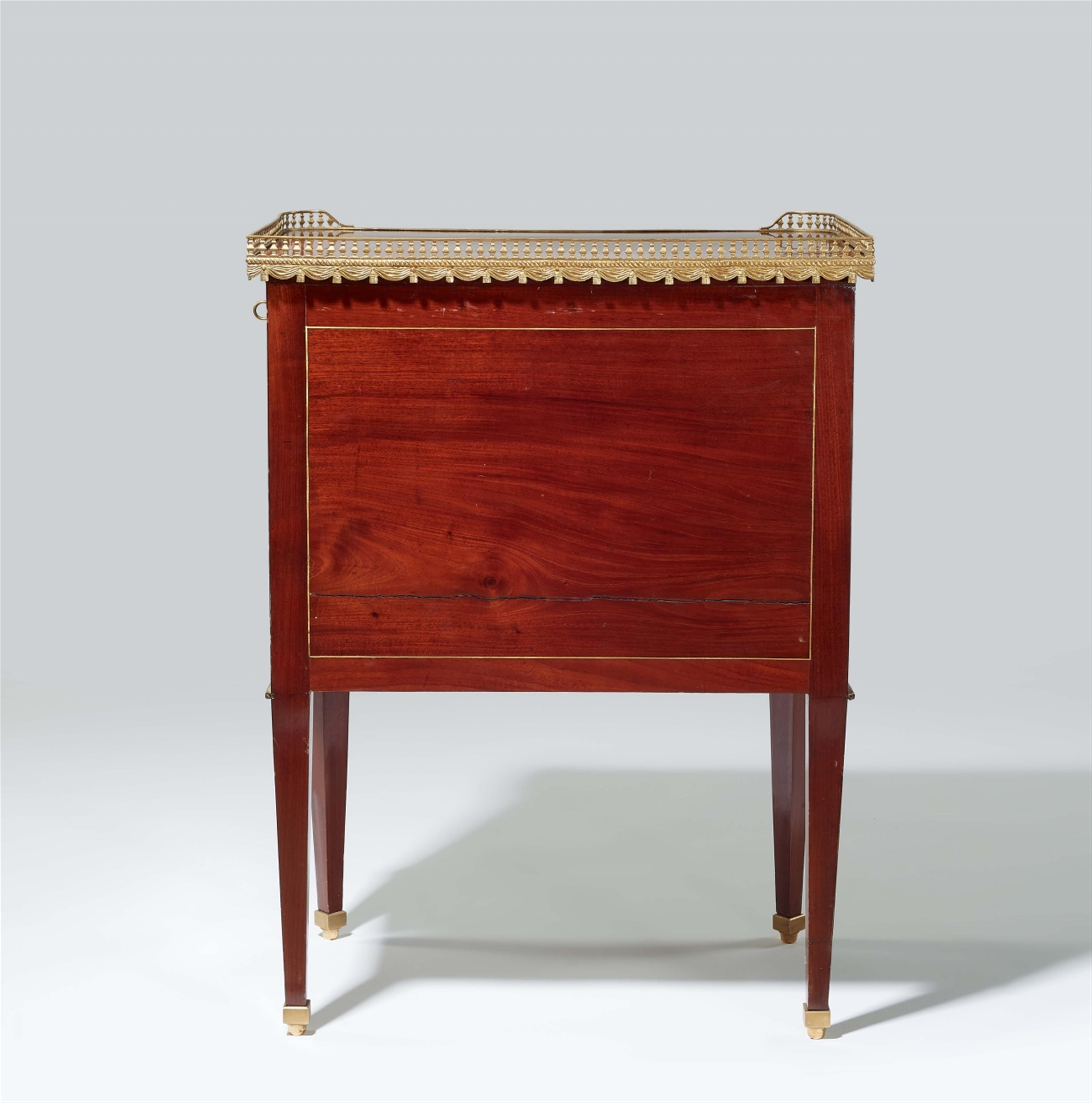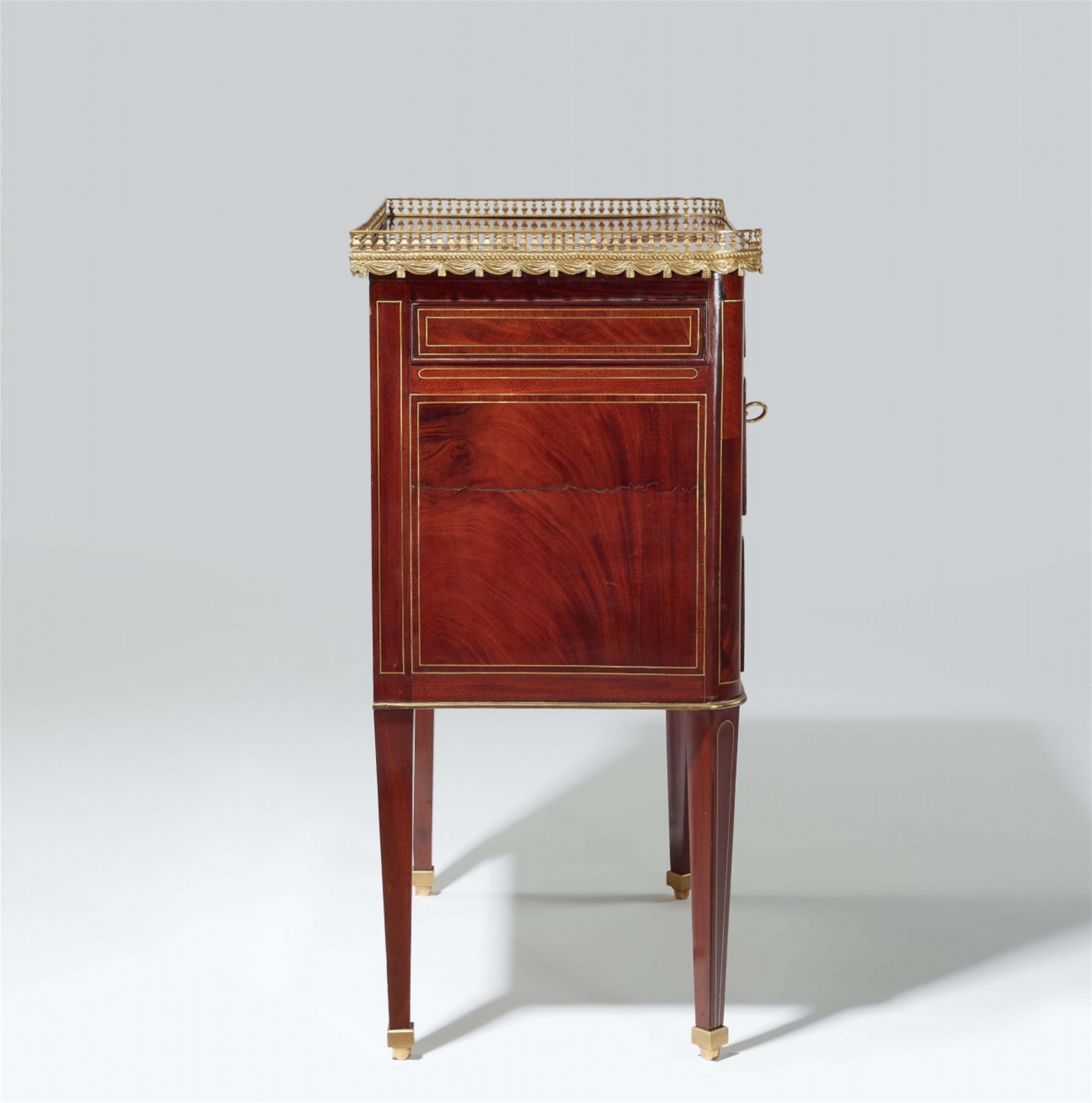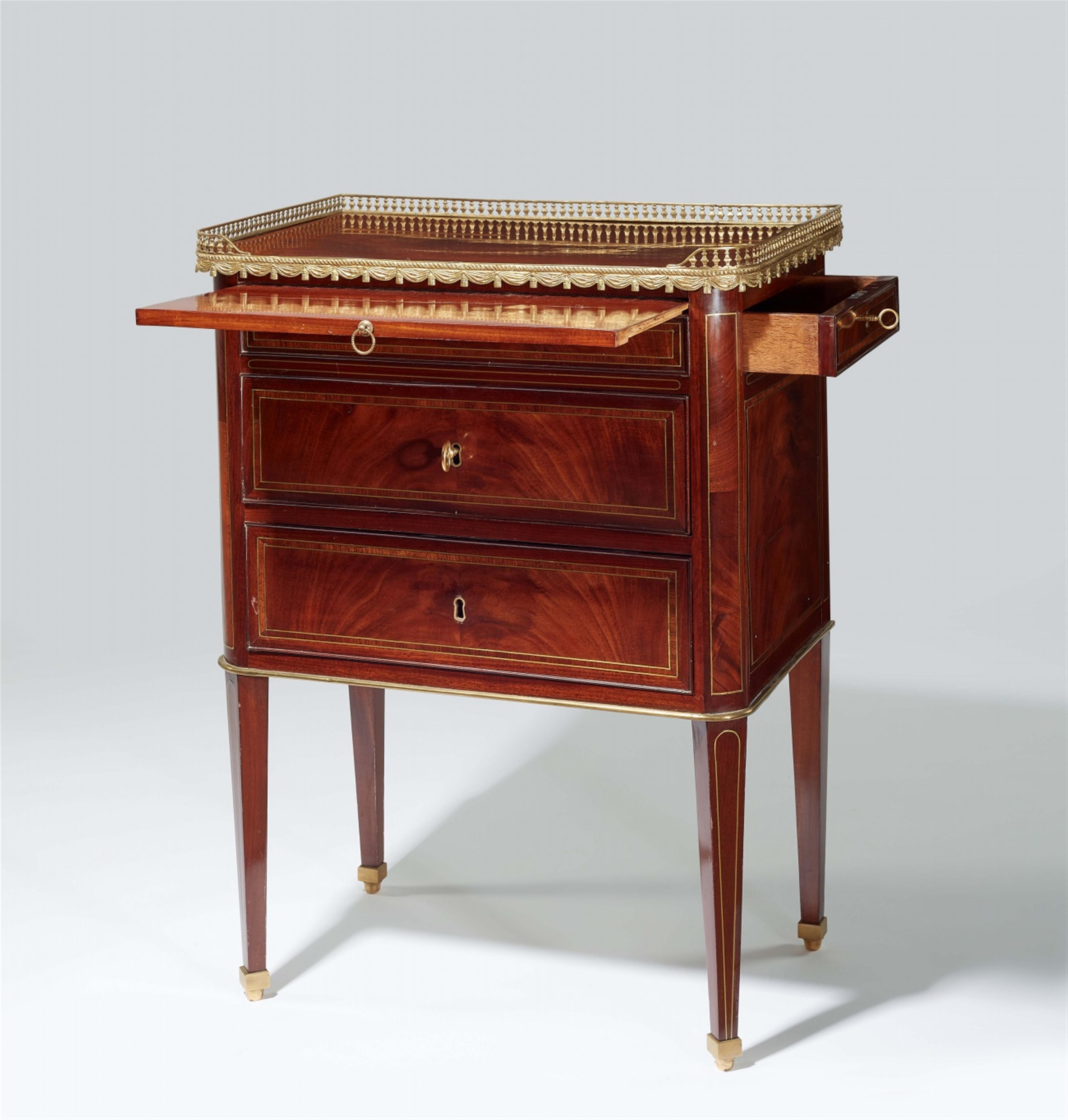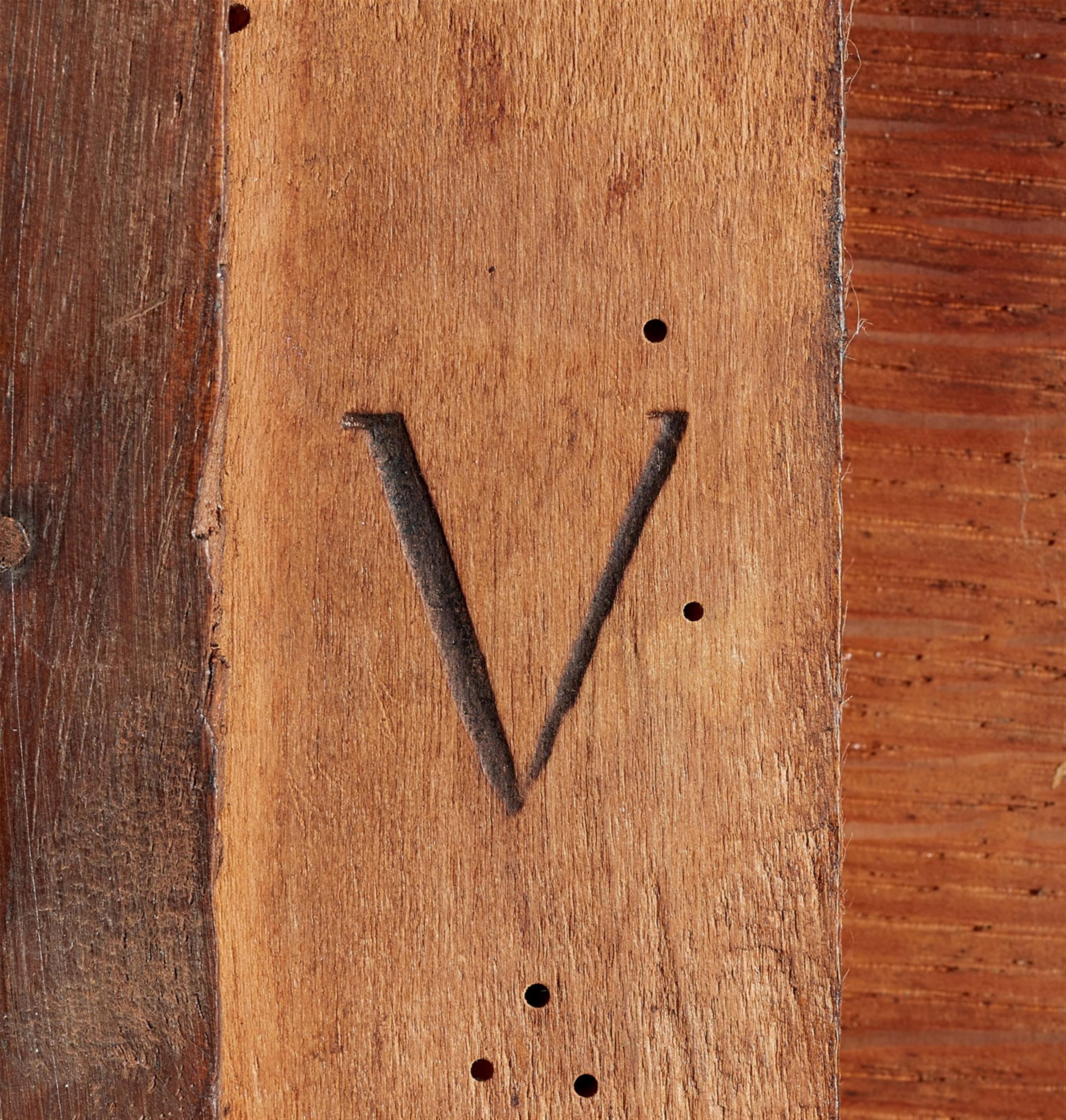A writing cabinet from the palace of Versailles
Mahogany and oak veneer on softwood with brass and ormolu mountings. Angular writing cabinet with rounded corners on tall, tapering supports. The two large lower drawers can be opened from the front, a further shallow drawer can be opened out to the right. All drawers with brass filet surrounds. Under the top is a writing surface which can be pulled out via a ring. The top encompassed by a shallow brass gallery. Stamped "J.G.FROST" beneath the back apron and with branded inventory stamp "V" beneath the left apron. H 77, W 56.5, D 37 cm.
Jean Gotlieb Frost, c. 1785 - 89.
Numerous archival records have survived telling us about the cabinetmaker Johann Gottlieb Frost, who was born in Berlin in 1751. Like many other outstanding craftsmen, he led a turbulent life in turbulent times. In 1779, he is listed among the employees of the workshop of Abraham and David Roentgen in Neuwied under no. 16, but is noted as "commis in Paris". Frost was contractually bound to Roentgen until 1785, selling furniture made in Neuwied in Paris. In 1782, he married in the Lutheran chapel of the Swedish embassy in Paris. On December 14th 1785 he acquired the title of master cabinetmaker from the City of Paris and founded his own workshop under the name of Jean Gotlieb Frost. He had to file for bankruptcy in the year of the Revolution, but resumed work under the name "Frost & Co” in 1790. Following a further bankruptcy in 1791, he was employed in the Paris police prefecture.
Writing cabinet by Johann Frost (1785-1789)
This two-drawered cabinet with an extendable writing surface and side compartment was produced by Johann Gottlieb Frost. Frost, who originally came from Berlin, began his career as an employee in David Roentgen's workshop in Neuwied. Frost accompanied David Roentgen during the establishment of the workshop's Paris branch in 1780, where he remained, initially working on a commission basis.
After Frost himself was admitted as a master craftsman to the Parisian Corporation des Menuisiers-Ebénistes in 1785, he took over the management of Roentgen's branch on his own until his company filed for bankruptcy for the first time in the autumn of 1789, due to the economic crisis triggered by the turmoil of the French Revolution. However, with the financial help of J.-B. Colombet, the company was refounded under the name of Frost & Cie, remaining in business until it was forced to file for bankruptcy for the second and final time in 1792.
This piece of furniture bears the stamp of Johann Gottlieb Frost and beside it we see a brand mark “V”. This inventory mark is known and is identified by Nicolay as an inventory stamp of the palace of Versailles. Since Frost is documented as a supplier to the royal administration of the Menus Plaisirs, the piece could have reached Versailles via this institution.
Although the work at first appears to be a cabinet, it features some peculiarities in the design which suggest that this unusual combination piece may be a unique work produced according to customer specifications. The idea to combine a cabinet with a desk is based on English and French designs. This type of cabinet concealing a shallow drawer in the frieze or pediment was a standard design among English furniture makers in the latter half of the 18th century.
Many small tables with writing leaves and small side drawers for stationery were also produced for the French court in the years between 1778 and 1788, most notably by Riesener. These pieces enjoyed high popularity due to their portability and versatility. It was Frost's stroke of genius to combine the English design of a chest of drawers with a writing surface and Riesener's French writing table to create an entirely new type.
The corpus is veneered on all faces, which allowed the piece to be placed freestanding in the room. The front features two drawers and a veneered writing surface below the top. Frost creatively concealed the frieze of the side drawer on the front of the piece with a veneered panel. The corners of the front are rounded, a feature often found in Parisian cabinets and one that was particularly popular in the years leading up to the Revolution. The mahogany veneer is of exquisite quality, with the front and sides utilising a vertical grain and the top and back a horizontal one.
Individual elements of the design, such as the supports, fronts of the drawers, frieze, sides, and back, are framed by brass stringing in order to accentuate the structure of the piece. The double borders around the drawers and the frieze emphasise their functionality. The eschewal of decorative bronze mountings on the work's corpus is unusual. Bronzes are only used on the supports as protective covers for the feet and as a surround for the top. The model used for the bronze mountings of the feet is cuboid and shows similarity to the English spade foot type, which resembles an acorn. This idiosyncratic form is found already in the designs of David Roentgen, who used it for his oval writing tables. The model was probably produced in Paris and can also be found in later works by Bernard Molitor and Johann Frost.
Three sides of the cabinet top are encircled by a gilt bronze baluster gallery above a cord with draperies and tassels. The design of a frieze with draperies and tassels in imitation of fabric is found in works by Martin Carlin. In this piece, the bronze model has been used as a gallery instead of a frieze and is characterised by an almost three-dimensional quality. It may have been made by the ciséleur-doreur Francois Remond. Beginning in around 1779, Remond created numerous bronze mountings after designs by Christian Baulez, first for David Roentgen and later for Frost.
A rounded brass moulding encompasses the lower edge of the cabinet above the supports. Both the gallery and this moulding accentuate the rounded corners of the piece. The locks are protected by plain lockplates in brass à l'anglaise. The drawers are fashioned without drawer pulls and are opened using the keys, whilst the writing surface can be extended via a metal ring in the centre.
The cabinet is an excellent example of a unique and practical small format piece, illustrating the spirit of assimilation of English and French models combined with the perfect craftsmanship typical of Parisian luxury furniture. It was this type of unusual and exquisitely rendered work especially that allowed cabinetmakers from Germany to establish themselves on the already over-saturated Parisian luxury market.
Ulrich Leben
Bibliography:
Francois de Salverte, Les Ebénistes du XVIIIe siècle, Vanoest Editeur, Paris, 1927, p. 131
Jean Nicolay, L'art et la Manière des maîtres Ebénistes Français au XVIIIe siècle , vol. 2, Pygmalion, Paris,1986, p. 702
Christian Baulez,“Tout Paris tire ses bronzes de Paris“ in, Ulrich Leben, Bernard Molitor, Ville de Luxembourg, 1995, p. 81
Literature
For more information on Frost's life, cf.: Roentgenmöbel aus Neuwied, Bad Neustadt 1986, illus. 659 f. and: Fabian, Abraham und David Roentgen. Das noch aufgefundene Gesamtwerk ihrer Möbel- und Uhrenkunst in Verbindung mit der Uhrmacherfamilie Kinzing in Neuwied. Leben und Werk, Verzeichnis der Werke, Quellen, Bad Neustadt 1996, p. 286 f.
de Salverte, Les Ebénistes du XVIIIe siècle, Paris 1927, p. 131.
Nicolay, L’art et la Manière des maîtres Ebénistes Français au XVIIIe siècle, vol. 2, Paris 1986, p. 702.
Baulez,“Tout Paris tire ses bronzes de Paris“ in: Leben, Bernard Molitor, Luxembourg 1995, p. 81.

